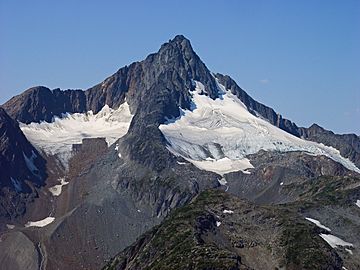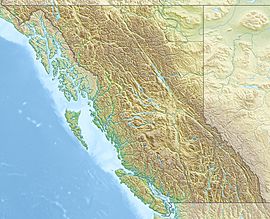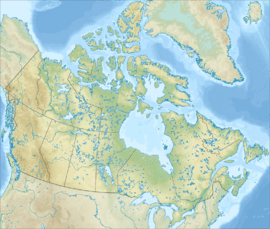Kwoiek Needle facts for kids
Quick facts for kids Kwoiek Needle |
|
|---|---|

Kwoiek Needle, northeast aspect
|
|
| Highest point | |
| Elevation | 2,625 m (8,612 ft) |
| Prominence | 595 m (1,952 ft) |
| Parent peak | Kumkan Peak (2742 m) |
| Geography | |
| Location | British Columbia, Canada |
| Parent range | Lillooet Ranges Coast Ranges |
| Topo map | NTS 92.I.4 |
| Geology | |
| Age of rock | Cretaceous |
| Type of rock | granodiorite |
| Climbing | |
| First ascent | 1890 |
| Easiest route | Scrambling |
Kwoiek Needle is a tall mountain in southwestern British Columbia, Canada. It stands at 2,625-metre (8,612-foot) high. This mountain is part of the Lillooet Ranges.
It is about 24 km (15 mi) southwest of a town called Lytton. The closest higher mountain is Kumkan Peak, which is 9.2 km (6 mi) to the west.
The name Kwoiek comes from the Thompson Indian language. It means "gouged out." This name refers to a large piece that looks like it's missing from a nearby canyon wall. The name was officially chosen on October 6, 1936.
Water from melting glaciers on the mountain's north side flows into Kwoiek Creek and Log Creek. These creeks then join the larger Fraser River.
What is the Climate Like at Kwoiek Needle?
Kwoiek Needle is in a subarctic climate zone. This means it has long, cold winters and short, cool summers. Most of the weather comes from the Pacific Ocean. These weather systems travel east towards the Coast Mountains.
When the air hits the mountains, it is forced to rise. This process is called Orographic lift. As the air rises, it cools and drops its moisture as rain or snow. Because of this, the Coast Mountains get a lot of precipitation, especially heavy snowfall in winter.
Temperatures can drop very low, sometimes below −20 °C. With the wind, it can feel even colder, below −30 °C. The best time to climb Kwoiek Needle is usually from July through September. During these months, the weather is most favorable for outdoor activities.
Climbing Routes on Kwoiek Needle
Kwoiek Needle offers several established routes for climbers. These routes are often rated using a system that tells climbers how difficult they are. The numbers below refer to the YDS rating, which describes the technical difficulty of the climb.
Here are some of the main climbing routes on Kwoiek Needle:



